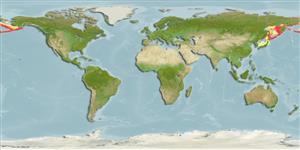Preferred temperature (Fonte Biblio.
123201): 0.7 - 5.4, mean 1.7 °C (based on 287 cells).
Phylogenetic diversity index (Fonte Biblio.
82804): PD
50 = 0.7500 [Uniqueness, from 0.5 = low to 2.0 = high].
Bayesian length-weight: a=0.00759 (0.00559 - 0.01030), b=3.03 (2.94 - 3.12), in cm total length, based on LWR estimates for this species (Ref.
93245).
Trophic level (Fonte Biblio.
69278): 4.3 ±0.2 se; based on diet studies.
Generation time: 13.7 ( na - na) years. Estimated as median ln(3)/K based on 2
growth studies.
Resilienza (Fonte Biblio.
120179): Basso, tempo minimo di raddoppiamento della popolazione 4.5 - 14 anni (Assuming tm>4; tmax=33; K=0.08).
Prior r = 0.18, 95% CL = 0.12 - 0.27, Based on 2 full stock assessments.
Fishing Vulnerability (Ref.
59153): High vulnerability (64 of 100).
🛈
Climate Vulnerability (Ref.
125649): Moderate vulnerability (44 of 100).
🛈
Nutrients (Ref.
124155): Calcium = 20.2 [8.0, 35.3] mg/100g; Iron = 0.244 [0.123, 0.466] mg/100g; Protein = 17.2 [15.9, 18.6] %; Omega3 = 0.375 [0.180, 0.771] g/100g; Selenium = 26.7 [13.1, 59.3] μg/100g; VitaminA = 10.3 [2.3, 45.7] μg/100g; Zinc = 0.281 [0.186, 0.427] mg/100g (wet weight);
